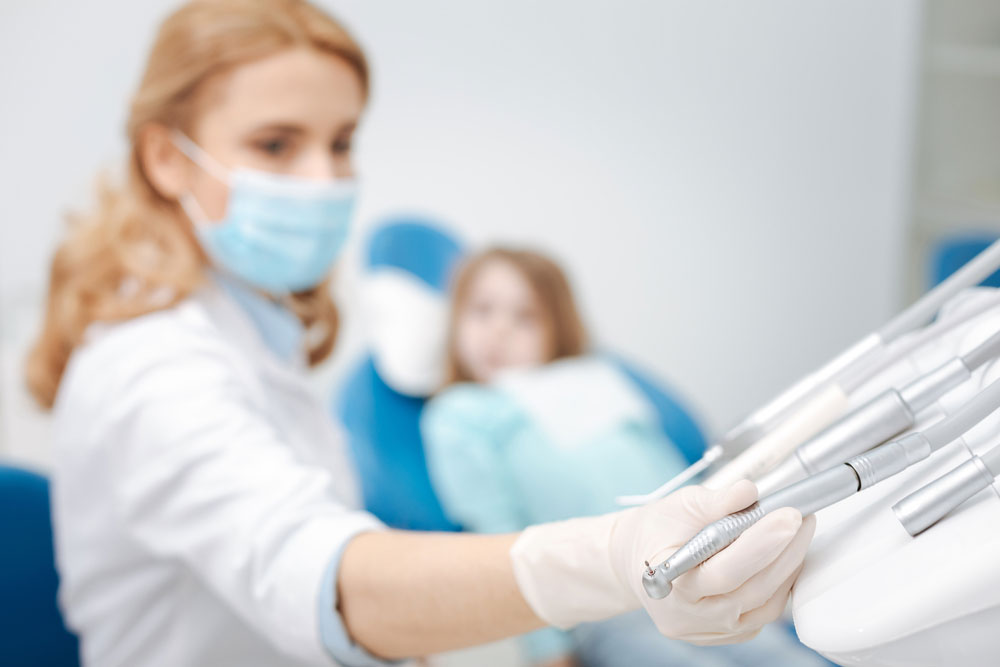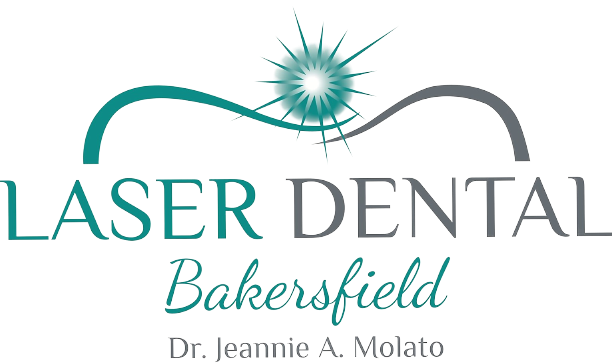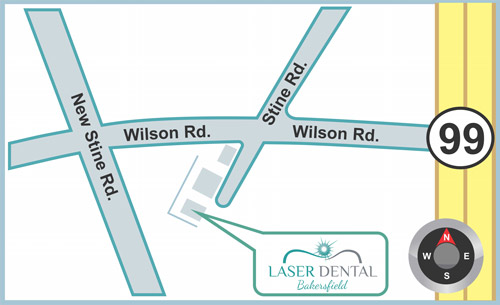The temporomandibular joint (TMJ) plays a vital role in everyday actions like chewing, speaking, and swallowing. Located on each side of the head, this joint connects the jaw to the skull, allowing for smooth jaw movement. TMJ disorders, however, can disrupt these essential functions, leading to discomfort and limited mobility. TMJ issues can arise from a variety of causes and impact individuals differently, making timely diagnosis essential for effective treatment.
This guide provides an overview of TMJ, exploring its causes, symptoms, and diagnostic methods. If you’re in Bakersfield and experiencing TMJ-related discomfort, Dr. Jeannie Molato and the team at Laser Dental Bakersfield offer expertise in evaluating and managing this complex joint disorder.
What is TMJ?
TMJ, or the temporomandibular joint, functions as a hinge that connects your jawbone to the skull. It enables the jaw’s movements necessary for actions like talking, eating, and facial expressions. Due to its complex structure and frequent use, the TMJ is susceptible to stress, misalignment, and injury. TMJ disorder (TMD) is the collective term for various conditions that cause pain and dysfunction in this joint, often disrupting daily life.
Common Causes of TMJ Disorders
Understanding the causes of TMJ disorders helps in determining the best approach to management and treatment. Here are some common factors that contribute to TMJ issues:
- Jaw Misalignment
The alignment of the jaw plays a significant role in joint function. Misalignment can place undue stress on the TMJ, causing pain and difficulty in movement. - Arthritis
Arthritis, including osteoarthritis and rheumatoid arthritis, can affect the TMJ, leading to inflammation, joint degradation, and limited mobility. - Injury or Trauma
A direct impact on the jaw, neck, or head from accidents or physical activity can damage the TMJ, resulting in pain and restricted movement. - Stress and Teeth Grinding
Chronic stress often leads to clenching or grinding of the teeth, which exerts excessive pressure on the TMJ. Over time, this can cause joint inflammation and pain. - Genetics
Some individuals are genetically predisposed to TMJ issues. Factors such as joint hypermobility or abnormal jaw structure can increase the likelihood of developing TMJ disorders. - Connective Tissue Disorders
Conditions that affect connective tissues, such as Ehlers-Danlos syndrome, can cause joint instability, making the TMJ more vulnerable to dysfunction.
Recognizing Symptoms of TMJ Disorders
TMJ disorders can manifest in a variety of ways, often mimicking other conditions. Here are some key symptoms to watch for:
- Jaw Pain
Pain around the jaw is a hallmark symptom, especially if it worsens with chewing, speaking, or other jaw movements. - Limited Jaw Mobility
Difficulty in opening or closing the mouth fully can signal a TMJ disorder. Some individuals may experience a sensation of the jaw “locking” in place. - Clicking or Popping Sounds
Clicking, popping, or grating noises when moving the jaw are common in TMJ disorders. However, these sounds may not always accompany pain. - Headaches and Ear Pain
TMJ issues can lead to tension headaches and earaches, as the joint is located near the ears and head. - Facial Swelling
In some cases, inflammation can cause swelling on the affected side of the face, contributing to discomfort and tenderness. - Neck and Shoulder Pain
The TMJ is connected to various muscle groups. Dysfunction in the joint can create strain that extends to the neck and shoulders.
How TMJ Disorders Are Diagnosed
TMJ disorders are multifaceted, and diagnosing them requires a comprehensive evaluation. Dr. Jeannie Molato at Laser Dental Bakersfield uses a variety of diagnostic techniques to identify TMJ issues accurately.
- Medical History Review
A detailed medical history is the first step. This review may include questions about past injuries, dental treatments, and habits like teeth grinding or jaw clenching. - Physical Examination
The physical exam involves assessing jaw movement and identifying tender areas around the TMJ. The doctor may listen for any popping or clicking sounds during jaw movement. - Imaging Tests
Imaging, such as X-rays, MRI, or CT scans, can provide valuable insights into the joint’s structure and reveal any abnormalities. These images help the dentist detect misalignment, joint deterioration, or other structural issues. - Bite Analysis
A bite analysis may be performed to examine how the teeth come together. Irregularities in bite alignment can contribute to TMJ dysfunction, and addressing these can alleviate symptoms. - Ultrasound or Doppler Imaging
Advanced ultrasound techniques or Doppler imaging can sometimes be used to assess soft tissue around the TMJ and check for abnormal joint movement.
Risk Factors for Developing TMJ Disorders
While TMJ disorders can affect anyone, certain factors increase the likelihood of developing this condition:
- Gender
TMJ disorders are more common in women than men, possibly due to hormonal differences affecting joint function. - Age
Young to middle-aged adults are at higher risk of TMJ issues, although symptoms can develop at any age. - Lifestyle Factors
High-stress lifestyles that lead to teeth grinding or jaw clenching increase the risk of TMJ disorders. Additionally, habits like chewing gum or biting fingernails may exacerbate symptoms.
Treatment Options for TMJ Disorders
Treatment for TMJ varies based on the disorder’s severity and underlying cause. Some effective treatment options include:
- Lifestyle Modifications
Avoiding certain foods, managing stress, and practicing relaxation techniques can reduce strain on the TMJ. - Medication
Anti-inflammatory drugs, muscle relaxants, and in some cases, antidepressants, are used to manage pain and inflammation. - Physical Therapy
Targeted exercises can help improve jaw mobility and reduce stiffness. A physical therapist might guide patients through exercises aimed at strengthening jaw muscles and enhancing function. - Dental Splints or Mouthguards
These devices can be customized to prevent teeth grinding and align the jaw properly, easing stress on the TMJ. - Minimally Invasive Procedures
In cases of severe pain, corticosteroid injections or Botox can provide temporary relief by reducing muscle tension around the TMJ. - Surgical Options
Surgery is typically considered a last resort if conservative treatments fail. Procedures may involve correcting joint structure, removing damaged tissue, or repositioning the jaw.
When to Seek Help
If you experience persistent jaw pain, limited mobility, or frequent headaches, seeking medical attention is crucial. Early diagnosis and treatment improve the chances of managing TMJ effectively, minimizing pain, and restoring normal function. Laser Dental Bakersfield, led by Dr. Jeannie Molato, provides a comprehensive evaluation of TMJ disorders, offering personalized treatment plans to address each patient’s unique needs.
Empowering Your TMJ Health
Living with TMJ discomfort can be challenging, but proactive steps can help you manage symptoms and regain comfort. From lifestyle adjustments to specialized treatments, there are numerous ways to achieve relief. At Laser Dental Bakersfield, we prioritize patient education, guiding you toward effective solutions that suit your lifestyle. Understanding the causes and symptoms of TMJ empowers you to take control of your health and make informed choices for long-term well-being.
Sources:
- Kaplan, P. A., Holliday, R. A., & Mace, J. D. (1991). Temporomandibular Joint Disorders. Radiology.
- Okeson, J. P. (2019). Management of Temporomandibular Disorders and Occlusion. Elsevier Health Sciences.
- Greene, C. S. (2001). The Etiology of Temporomandibular Disorders: Implications for Treatment. Journal of Orofacial Pain.










